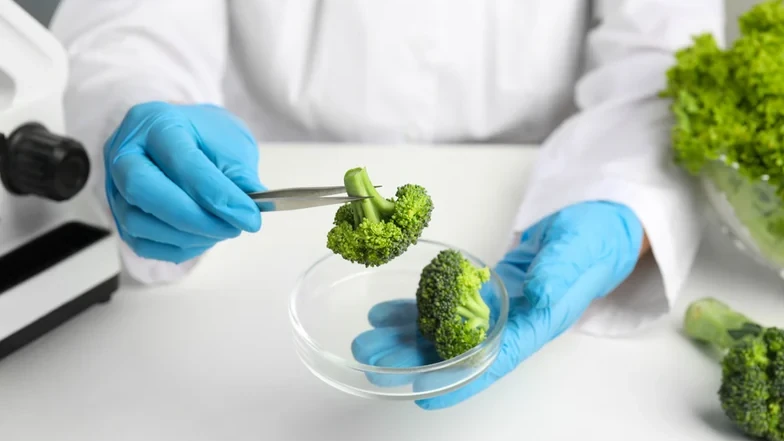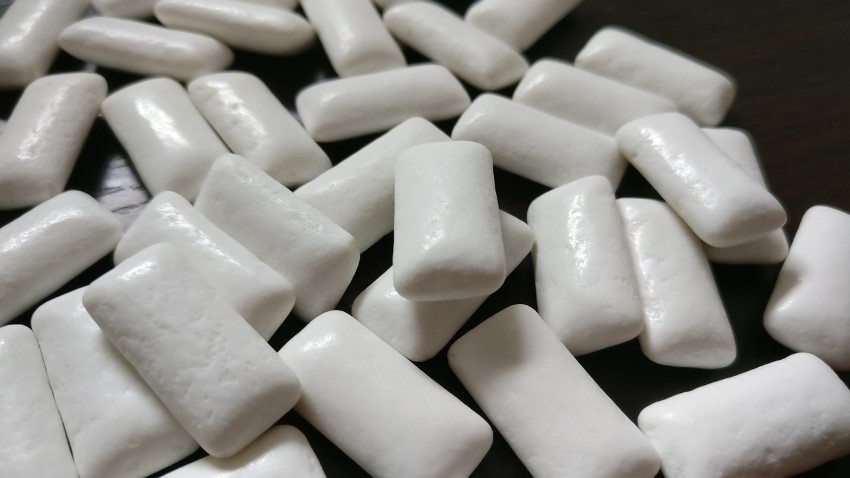Potato salad with foreign plastic. Mixed greens with listeria exposure. Ice cream with metal fragments. Cookies with undeclared nut allergens. Dried pasta with mold contamination.
These are just a few examples of recent food recalls issued by the U.S. federal government.
Food recalls frequently generate headlines and public concern because of their associated safety risks and health hazards. To help protect consumers, government officials have developed a system of regulation and oversight that identifies potentially unsafe products and issues recalls that get those products off of store shelves and out of consumers’ homes.
This system of oversight is a shared responsibility of the U.S. Food and Drug Administration and the U.S. Dept. of Agriculture. Each agency is authorized by law to oversee certain types of farms and food production facilities, with sometimes overlapping jurisdiction. As the agencies identify hazardous products, they can issue recalls to minimize risks to consumers.
Both the USDA and the FDA distinguish between Class I, Class II, and Class III food recalls to signify the level of risk associated with each. While the two agencies’ systems are slightly different, the general classifications used are similar. Class I recalls are for the most hazardous products, which have higher risks of causing serious adverse health consequences or death, while Class II recalls have more moderate risks and Class III recalls have minimal risks.
Trends in U.S. Food Recalls
The total number of food recalls increased by 15% between 2020 and 2024
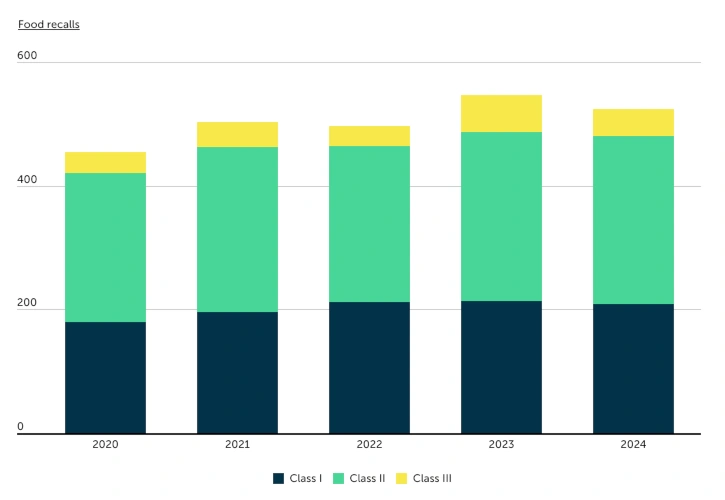
Credit: Trace One analysis of 2020–2024 FDA and USDA data.
Over the past few years, the number of food recalls issued by the two agencies has increased. From 2020 to 2023, the total number of recalls grew from 454 to 547, an increase of more than 20%. This growth took place across all classes of recall, but notably the number of Class I recalls has increased in each year since 2020. And while the volume of food recalls declined slightly in 2024, it remained over 15% higher than in 2020.
Common Causes of Food Recalls
Allergen contamination is responsible for the largest share of recalls
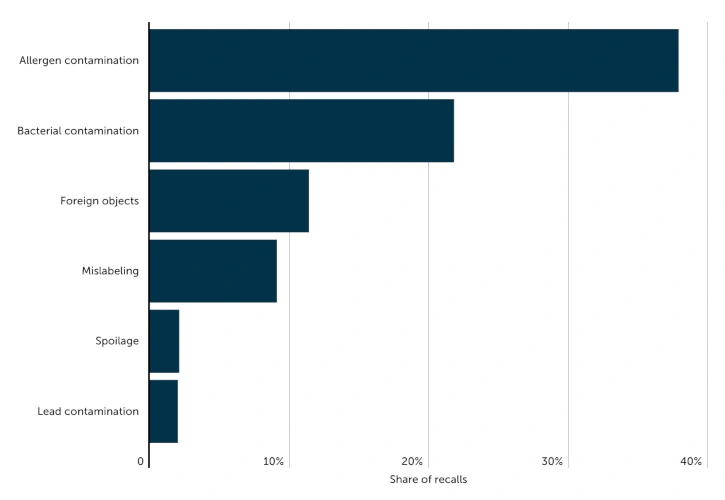
Credit: Trace One analysis of 2020–2024 FDA data.
The leading causes of food recalls are allergen, bacterial, and foreign object contamination. Allergen contamination, responsible for nearly 38% of all cases, occurs when products are exposed to allergens like wheat, dairy, and nuts, often due to cross-contamination during manufacturing. Even trace amounts can trigger severe allergic reactions in sensitive individuals, making prevention and accurate labeling crucial.
Bacterial contamination follows at 21.8%, with recalls for pathogens like salmonella, E. coli, and listeria. These bacteria can cause serious illness, particularly in vulnerable populations such as young children, the elderly, and those with weakened immune systems. Infections can lead to severe gastrointestinal distress, long-term health complications, and even death.
Foreign object contamination accounts for 11.4% of recalls and includes materials such as rocks, insects, plastic, or metal. These contaminants can cause physical harm, such as choking, dental damage, or internal injuries if ingested.
The least common but highly concerning are lead contamination recalls, comprising just 2.0% of the total between 2020-2024, yet attracting significant public attention due to their severe health risks. Recent high-profile lead recalls include contaminated applesauce pouches, which garnered extensive media coverage due to the potential harm to vulnerable populations.
What Should Consumers Do When They Learn About a Food Recall?

What you should do after learning about a food recall depends on the severity and reason for the recall. Some recalls, like those for undeclared allergens, may not pose a risk to you if you don’t have an allergy, while others—such as bacterial contamination or lead exposure—require immediate action.
The first priority is to confirm whether you have the recalled item by checking details like the brand, product name, geographic distribution, and expiration date, which are usually provided in the official press release. If you have the recalled product, the FDA recommends checking the recall notice for specific instructions. In many cases, you can return the item for a refund, but if the product is contaminated, it’s best to seal it in a bag and dispose of it properly. Never donate recalled food or feed it to pets, as it may still pose a risk to others.
If the recalled item was stored in your kitchen, clean any surfaces it may have touched, including countertops, utensils, and refrigerator shelves, with a proper sanitizing solution. If you or anyone in your household has consumed the product, watch for symptoms such as nausea, vomiting, diarrhea, or fever, especially if the recall involves bacteria or toxins. Seek medical attention if symptoms appear, particularly for those who are pregnant or have weakened immune systems. If you believe a food product has made you sick, reporting it to the FDA or USDA can help prevent further harm to others.
This post is adapted from the article States Most Impacted by Food Recalls in Recent Years, which originally appeared in the PLM Compliance Blog and was written by Erika Redaelli, Global Head – Regulatory and Scientific Affairs at Trace One
About Erika Redaelli
Professional with 10+ years of experience in the food & beverage industry, with emphasis on global product innovation and renovation. Having covered several technical roles, from regulatory & scientific affairs to R&D, both with local and international reach, Erika has a clear understanding of the complexity and challenges of end-to-end compliance in a fragmented regulatory environment, as well as a deep resonance with the struggles and hurdles the players face in their day to day.
Trace One is a global leader with over 30 years of experience specializing in regulatory compliance and PLM solutions for the food and beverage industry. Its work has been featured in Newsweek, MSN, USA Today, ABC, and more. Additional insights are available upon request.
